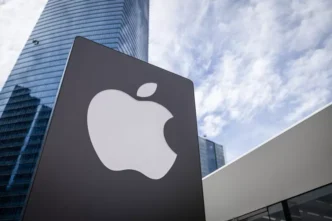Apple is once again on the brink of rewriting stock market history. The company’s shares surged 4.5% on Monday, closing at $263.70 and lifting its market value to $3.91 trillion, just a short rally away from becoming the third company ever to hit the $4 trillion milestone. The climb comes on the back of impressive iPhone 17 sales, which have significantly outperformed expectations in major markets like the United States and China.
According to new data from Counterpoint Research, the iPhone 17 lineup has exceeded the performance of the iPhone 16 series by 14% during the first 10 days of availability. This rebound marks a crucial moment for Apple, which had faced months of uncertainty due to weakening smartphone demand and increased competition from Chinese rivals such as Huawei and Xiaomi. The early success of the iPhone 17 has reignited investor confidence in Apple’s hardware business and sparked optimism for a strong holiday season.
Counterpoint’s senior analyst Mengmeng Zhang explained that the new base model has struck a perfect balance between performance and value. She noted that the iPhone 17 comes equipped with a faster A19 Bionic chip, a more vibrant ProMotion display, higher base storage, and an upgraded front camera, all for the same price as last year’s iPhone 16. Combined with regional discounts and trade-in incentives, Zhang described it as a “no-brainer purchase” for many consumers, especially those upgrading from older models.
Apple’s renewed growth is remarkable considering its position just a year ago. In December 2024, the company briefly flirted with the $4 trillion mark, buoyed by investor excitement over its AI-driven ambitions. Those initiatives, including on-device AI processing, enhanced Siri capabilities, and deeper ecosystem intelligence, represented Apple’s answer to slowing device sales and investor pressure to show innovation beyond the iPhone. At the time, Apple even managed to surpass Nvidia momentarily, riding the wave of AI-fueled optimism that has gripped Silicon Valley.
The resurgence of that investor enthusiasm is evident again this quarter. Over the weekend, Evercore ISI added Apple to its “Tactical Outperform List,” forecasting that the company will exceed Wall Street expectations in its upcoming quarterly results. Analysts cited early order data from China as a major tailwind, with preorders for the iPhone 17 reportedly outpacing other global regions at launch. They also believe the new online order system Apple introduced in China could sustain that demand into the December quarter.
Meanwhile, Loop Capital raised its price target for Apple from $226 to $315 per share and upgraded the stock from “hold” to “buy,” suggesting strong momentum and investor conviction in Apple’s recovery. Analysts noted that the company’s renewed focus on product quality, combined with supply chain stability and consumer demand, places Apple in a favorable position to end the year as one of the strongest-performing tech giants in the market.
Beyond product sales, Apple’s broader strategy is also resonating with investors. The company has been steadily integrating AI-driven features across its ecosystem, from photo editing and voice commands to proactive app suggestions and device optimization. These subtle yet impactful upgrades are part of what analysts call “Apple’s quiet AI revolution”, one that positions its hardware lineup as smarter, faster, and more intuitive without relying on cloud computing.
Apple’s rally also underscores its ability to navigate external pressures. In 2024, the company’s performance was weighed down by concerns about U.S. tariffs on Asian manufacturing hubs and slower recovery in markets like India. But its operational resilience and strong brand loyalty have allowed it to rebound faster than expected. The iPhone 17’s reception in China, a market that had shown signs of weakening interest, is particularly encouraging. Strong preorder numbers signal renewed trust from Chinese consumers and suggest that Apple’s localized marketing and online distribution strategy is paying off.
If Apple maintains its current momentum, the company is on track for its biggest one-day jump since August, paving the way for a record-breaking close to 2025. Investors and analysts alike are now watching its next major catalyst, Apple’s quarterly earnings report scheduled for October 30. A strong performance could be the final push needed for Apple to officially surpass the $4 trillion threshold, cementing its position as one of the most valuable and resilient companies in history.
For now, the iPhone 17’s success signals more than just another product win, it marks Apple’s return to growth, innovation, and market leadership at a time when the global tech sector is increasingly defined by AI, competition, and shifting consumer expectations.
Apple nears $4 trillion valuation as iPhone 17 sales jump 14% in the U.S. and China
Apple is once again on the brink of rewriting stock market history. The company’s shares surged 4.5% on Monday, closing at $263.70 and lifting its market value to $3.91 trillion, just a short rally away from becoming the third company ever to hit the $4 trillion milestone. The climb comes on the back of impressive iPhone 17 sales, which have significantly outperformed expectations in major markets like the United States and China.
According to new data from Counterpoint Research, the iPhone 17 lineup has exceeded the performance of the iPhone 16 series by 14% during the first 10 days of availability. This rebound marks a crucial moment for Apple, which had faced months of uncertainty due to weakening smartphone demand and increased competition from Chinese rivals such as Huawei and Xiaomi. The early success of the iPhone 17 has reignited investor confidence in Apple’s hardware business and sparked optimism for a strong holiday season.
Counterpoint’s senior analyst Mengmeng Zhang explained that the new base model has struck a perfect balance between performance and value. She noted that the iPhone 17 comes equipped with a faster A19 Bionic chip, a more vibrant ProMotion display, higher base storage, and an upgraded front camera, all for the same price as last year’s iPhone 16. Combined with regional discounts and trade-in incentives, Zhang described it as a “no-brainer purchase” for many consumers, especially those upgrading from older models.
Apple’s renewed growth is remarkable considering its position just a year ago. In December 2024, the company briefly flirted with the $4 trillion mark, buoyed by investor excitement over its AI-driven ambitions. Those initiatives, including on-device AI processing, enhanced Siri capabilities, and deeper ecosystem intelligence — represented Apple’s answer to slowing device sales and investor pressure to show innovation beyond the iPhone. At the time, Apple even managed to surpass Nvidia momentarily, riding the wave of AI-fueled optimism that has gripped Silicon Valley.
The resurgence of that investor enthusiasm is evident again this quarter. Over the weekend, Evercore ISI added Apple to its “Tactical Outperform List,” forecasting that the company will exceed Wall Street expectations in its upcoming quarterly results. Analysts cited early order data from China as a major tailwind, with preorders for the iPhone 17 reportedly outpacing other global regions at launch. They also believe the new online order system Apple introduced in China could sustain that demand into the December quarter.
Meanwhile, Loop Capital raised its price target for Apple from $226 to $315 per share and upgraded the stock from “hold” to “buy,” suggesting strong momentum and investor conviction in Apple’s recovery. Analysts noted that the company’s renewed focus on product quality, combined with supply chain stability and consumer demand, places Apple in a favorable position to end the year as one of the strongest-performing tech giants in the market.
Beyond product sales, Apple’s broader strategy is also resonating with investors. The company has been steadily integrating AI-driven features across its ecosystem, from photo editing and voice commands to proactive app suggestions and device optimization. These subtle yet impactful upgrades are part of what analysts call “Apple’s quiet AI revolution”, one that positions its hardware lineup as smarter, faster, and more intuitive without relying on cloud computing.
Apple’s rally also underscores its ability to navigate external pressures. In 2024, the company’s performance was weighed down by concerns about U.S. tariffs on Asian manufacturing hubs and slower recovery in markets like India. But its operational resilience and strong brand loyalty have allowed it to rebound faster than expected. The iPhone 17’s reception in China, a market that had shown signs of weakening interest, is particularly encouraging. Strong preorder numbers signal renewed trust from Chinese consumers and suggest that Apple’s localized marketing and online distribution strategy is paying off.
If Apple maintains its current momentum, the company is on track for its biggest one-day jump since August, paving the way for a record-breaking close to 2025. Investors and analysts alike are now watching its next major catalyst, Apple’s quarterly earnings report scheduled for October 30. A strong performance could be the final push needed for Apple to officially surpass the $4 trillion threshold, cementing its position as one of the most valuable and resilient companies in history.
For now, the iPhone 17’s success signals more than just another product win, it marks Apple’s return to growth, innovation, and market leadership at a time when the global tech sector is increasingly defined by AI, competition, and shifting consumer expectations.













